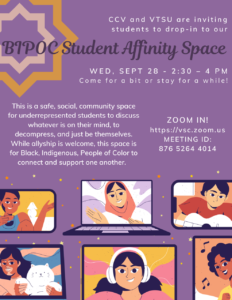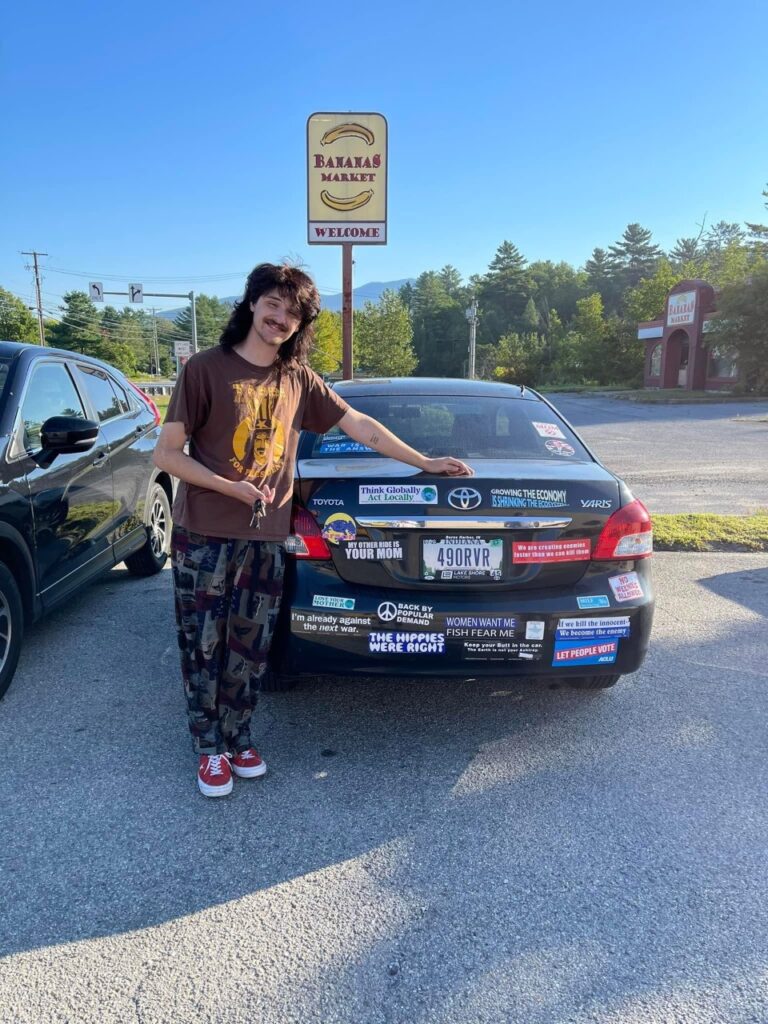A space for BIPOC students

On Sept. 28, the first meeting for the BIPOC Student Affinity Space took place over Zoom. The invitation went out to students across the Castleton, Northern Vermont University, Community College of Vermont and Vermont Technical College campuses.
“This is a safe, social, community space for underrepresented students to discuss whatever is on their mind, to decompress, and just be themselves,” read the email invitation from Chief Diversity Officer Jae Basiliere.
The idea for the group was born out of the Diversity, Equity and Inclusion Committee at CCV, and was “led by the students” on the committee, according to Mary Brodsky, CCV’s dean of people and culture. And they decided to open it up to the entire Vermont State University system.
“I saw this as an opportunity, because CCV has 12 different locations, to partner with Vermont State University, given numbers and thinking about making those connections that you might not already have and leveraging a virtual environment so that more people could participate,” Brodsky said.
The first meeting only had six student attendees.
“I always try to make sure that I am in touch with my roots and my sense of community, people who I can relate to. And so, it was just a little sad seeing that,” said NVU student Drey Raitt. “I’m gonna keep my mind open to going, though, I don’t want to stop going.”
Jack Taylor, a student at CCV and member of the DEI Committee, was hopeful as well.
“I hope that people do give it another shot, because I think the potential is there for it to turn into something really good. Something meaningful,” Taylor said.
VTC student Andrew Clark, who doesn’t identify as a person of color but was another participant in the first meeting, feels that the wording of the email may have deterred students from showing up.
“I’m all for student support and supporting other students in any way that we can. But the email almost made it sound like I wasn’t invited,” Clark said.
But, after some emails with Basiliere, he decided to attend.
“I went because supporting fellow students is important. And just to see what it was about, I suppose,” Clark said.
The space, while not intended to exclude white students, is geared toward students of color.
“While allyship is welcome, this space is for Black, Indigenous, People of Color to connect and support one another,” said Basiliere in their invitation email.
And this kind of space is important, especially because of the unique challenges BIPOC students face and the significance of being able to talk about these challenges.
“I see the value in having a space where you are together with people who are like minded might have similar experiences where you may not have to explain yourself as much,” said Brodsky, adding that “being able to just have that sense of community and not feeling like you have to put on a different sort of assimilation in a more homogenous environment” is important.
Mariah Kelley, a CCV student who attended the meeting, shared her experience being one of so few people of color in Vermont. While not always outwardly negative, it can be isolating, she said. On one occasion, when she was out in her neighborhood, a little girl saw her and her mother’s boyfriend at the time, who is Black, and said, “Oh, there’s a Black person and he’s real, too!”
“There’s not many people of color that are in sight in Vermont,” Kelley said, adding that being in these kinds of groups can be a reminder that, “they’re actually here, they’re just not visible to my eye all the time.”
Raitt, who is studying anthropology, sociology, and is deciding to include either ethnic or Chicano studies, shared her experiences in feeling singled out by professors as one of the only students of color.
“It’s just nice to talk to people who have also experienced this and can validate what you’re feeling. Because with racism on campus, it can be hard to see, it’s hard for others to see,” Raitt said.
And Taylor emphasized how these struggles intertwine with other social issues as well. In looking at the preliminary application for NVU, he noticed that under the gender section, there were only “male” and “female” options. Taylor pointed out that the College Board has this, as well, but also includes a message apologizing for the lack of inclusivity. NVU does not.
“If I’m considering this, that’s not a very welcoming sign, right?” Taylor said. “This is exactly why I want people to come to the affinity group. This is exactly why this is important.”
This sentiment of wanting more students to come to the next session was shared between all of the participants.
“I don’t really feel like you can go wrong with it. If you do decide to join if it’s not comfortable enough for you, then you don’t have to come a second time. But I’m almost positive that you’ll want to come again,” Kelley said.
Taylor recognizes that students of color may feel some hesitation over joining, though.
“I think often what happens, particularly if you are in a marginalized group or if you are underrepresented, then you tend to feel like when these things happen, they’re just kind of performative, right? ‘Oh, look, one more thing that is trying to make me feel included in an environment that I can’t possibly feel included in,’” Taylor said.
But as one of the students who participated in creating the group, he wants others to know that this is different.
“It’s not just lip service. It really is born out of a genuine interest to hear people’s experiences and voices and, if necessary, affect change. Or just share what’s going on and be empowered by one another,” he added.







